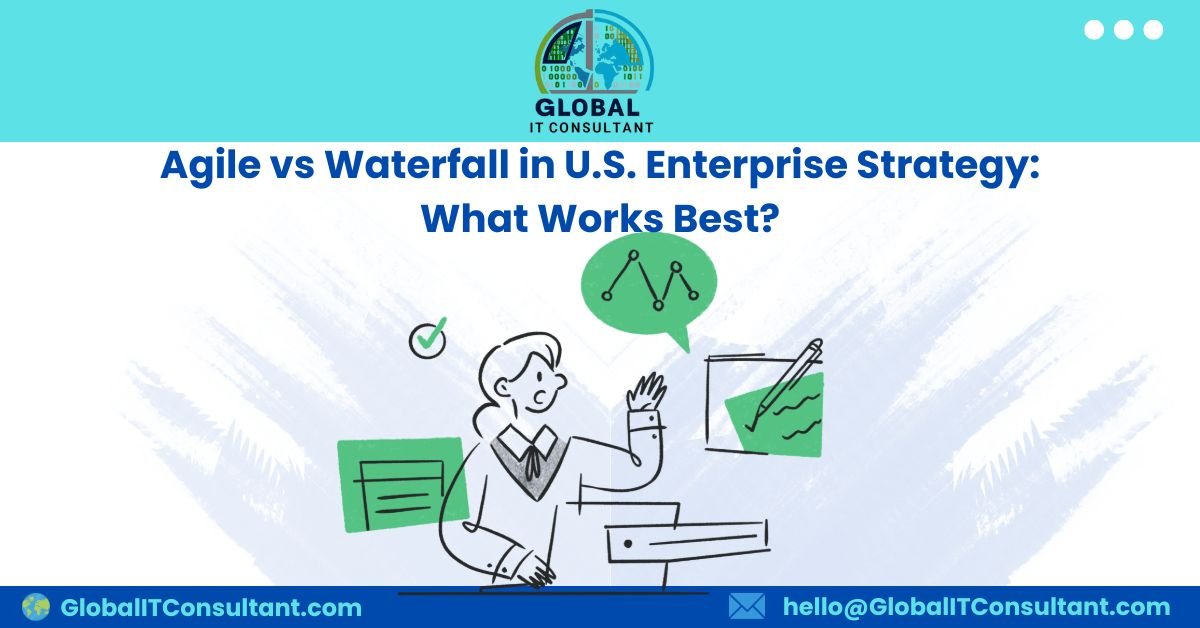By Global IT Consultant
When it comes to planning and executing large-scale digital and business initiatives, U.S. enterprises often face a strategic crossroads: Agile or Waterfall?
Both frameworks have shaped American enterprise strategy for decades—but they serve different goals, industries, and project types. At Global IT Consultant, we help organizations choose the right approach (or blend of both) to fit their culture, goals, and market realities.
In this blog, we break down Agile vs Waterfall, explore where each works best in the U.S. enterprise landscape, and share practical ways to decide what fits your next project.
🔍 What Are Agile and Waterfall?
Waterfall:
- Linear, sequential process
- Each phase (planning → design → implementation → testing → deployment) must finish before the next begins
- Works best when requirements are clear and unlikely to change
Agile:
- Iterative, incremental process
- Emphasizes flexibility, customer feedback, and collaboration
- Development happens in cycles (sprints), allowing for ongoing adaptation
🇺🇸 Why the Debate Matters for U.S. Enterprises
In the U.S., enterprises operate in highly competitive, often regulated markets:
- Tech firms must innovate fast
- Financial institutions must balance compliance and change
- Healthcare companies deal with strict data rules and evolving patient needs
Choosing the wrong framework can mean wasted resources, project delays, or compliance risks.
⚙️ Where Waterfall Works Best
✅ Highly regulated industries: Where documentation and traceability are critical (e.g., banking, aerospace, government contracts)
✅ Projects with fixed requirements: Infrastructure migrations, compliance-driven updates, or ERP rollouts where scope is stable
✅ Large budgets and longer timelines: When it’s feasible to plan thoroughly up front and stick to the plan
Key benefit: Predictability and control
🧩 Where Agile Shines
✅ Fast-changing markets: Startups, SaaS, digital products where customer needs evolve rapidly
✅ Innovation-focused projects: AI tools, mobile apps, or user-centric services
✅ Cross-functional teams: Encourages real-time feedback between IT, marketing, and operations
Key benefit: Flexibility and faster delivery of value
🏢 Hybrid & Scaled Agile: The Enterprise Trend
Many U.S. enterprises now adopt a hybrid approach:
- Use Waterfall for compliance-heavy back-end systems
- Use Agile for customer-facing apps or digital marketing projects
Frameworks like SAFe (Scaled Agile Framework) help large organizations coordinate Agile teams while retaining governance and documentation.
🧠 Questions to Help Decide
- Are requirements likely to change? → Agile
- Is documentation or compliance non-negotiable? → Waterfall or hybrid
- Do you need stakeholder feedback along the way? → Agile
- Do you need a fixed budget and timeline? → Waterfall
- Do you have distributed teams? → Agile (with tools like Jira, Slack)
🧪 Example: U.S. Retail Enterprise
A national retailer wanted to modernize its e-commerce and warehouse systems.
- Used Agile for website redesign and mobile apps → Faster iteration based on customer feedback
- Used Waterfall for ERP migration → Ensured integration and compliance
Result: Faster time-to-market without risking back-end stability.
✅ Final Thoughts
In U.S. enterprise strategy, it’s rarely about Agile vs Waterfall—it’s about which mix aligns best with your project’s risk, complexity, and market dynamics.
At Global IT Consultant, we help large organizations choose, customize, and implement the right delivery framework to meet strategic goals.
👉 Not sure which fits your next project?
Let’s explore it together.

